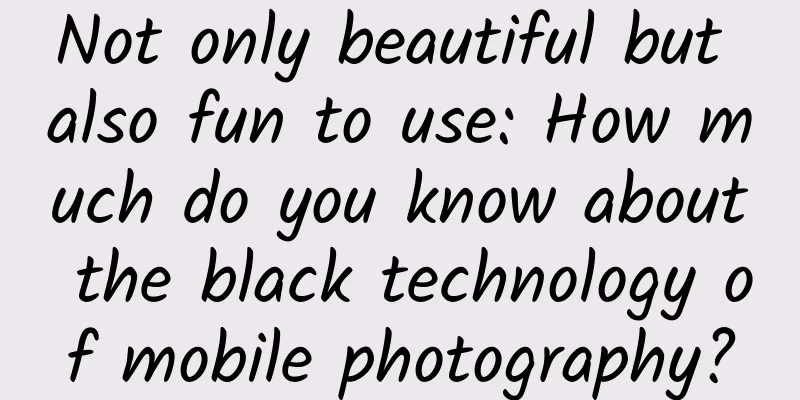Not only beautiful but also fun to use: How much do you know about the black technology of mobile photography?

|
Since the first generation of iPhone changed the world in 2007, smartphones have become a multifunctional personal terminal, and various technologies have become more and more sophisticated. Especially mobile phone photography, its level has already replaced the previous compact cameras. The threshold of digital photography has been lowered, and it has gradually become a part of people's daily life. From the initial 30W pixels to 1.3M pixels, then to 500W, 800W, 1600W, and even Nokia's 41M pixels, the indicators of mobile phone photography technology have grown rapidly. Of course, we are not here to talk about mobile phone pixels today. The iPhone's ancestral 800W beats all high-pixel ones. Today, let's talk about the various black technologies in mobile phone photography. 1. The first dual-camera phone - HTC Evo 3D (G17) Speaking of the earliest photography black technology, I believe that many people think of HTC's Evo 3D (G17) in 2011. It has two cameras on the back of the phone, but its function is not to adjust the depth of field as HTC later did. Instead, it is used to shoot 3D photos and 3D videos. This undoubtedly arouses people's curiosity. Can 3D photos be taken on mobile phones? Its imaging principle is as follows: Naked eye 3D technology is called "parallax barrier technology" or "light barrier technology". The principle of this 3D technology is similar to polarization 3D. Light barrier 3D products are compatible with existing LCD liquid crystal processes, so they have advantages in mass production and cost, but the image resolution and brightness of products using this technology will decrease. The parallax barrier 3D technology is implemented by using a switch LCD screen, a polarizing film and a polymer liquid crystal layer, and using the liquid crystal layer and the polarizing film to create a series of vertical stripes with a direction of 90°. Light barrier technology These stripes are tens of microns wide, and the light passing through them forms a vertical thin stripe pattern, which is called a "parallax barrier". This technology uses the parallax barrier placed between the backlight module and the LCD panel. In the stereoscopic display mode, when the image that should be seen by the left eye is displayed on the LCD screen, the opaque stripes will block the right eye; similarly, when the image that should be seen by the right eye is displayed on the LCD screen, the opaque stripes will block the left eye. By separating the visible images of the left eye and the right eye, the viewer can see the 3D image. However, due to the strong dizziness of users under this effect, and the actual use is weak, and the supported applications are also relatively few, so EVO 3D did not receive a good response in the market, and HTC never continued to use this technology after launching this generation. 2. Ultra-high pixels – Nokia Lumia 1020 In 2013, Nokia released an ultra-high-pixel mobile phone - Lumia 1020, which uses the second-generation PureView camera technology, is equipped with a xenon flash, and has a pixel of up to 41 million. This is not Nokia's first ultra-high-pixel mobile phone. The 808 released by Nokia the year before also had a pixel of 41 million. However, since it uses the Symbian system, it will not be discussed here. At the launch of 1020, Nokia announced that it uses Nokia's exclusive PureView technology. The photosensitive element uses a 1/1.5-inch (2/3-inch) 41-megapixel back-illuminated photosensitive element. At the same time, it is equipped with a 6-lens Zeiss lens to form the Lumia 1020's imaging system. It will change the shortcoming of low-pixel mobile phone photography and allow "photo first, then compose." In addition, Nokia has equipped it with a professional photography mode. On this interface, the camera's white balance, metering point and sensitivity can be adjusted at will. Coupled with the randomly included photo handle, it simulates the photography experience of a professional camera to the greatest extent possible. It can be said to be a true "SLR in a mobile phone." Due to the ultra-high pixel, the output photo size is too large, and the default is usually 500W pixels. And the subsequent consumer market also proved that users do not need such high pixels for the time being. So after 1020, this technology of Nokia disappeared. 3. HTC ONE (M7 M8) stands out While mobile phone pixels have been gradually moving towards higher resolutions, HTC took a different approach in 2013. Its flagship HTC ONE (m7) at the time was equipped with a camera with only 4 million pixels. Low pixel does not mean low image quality. In fact, it uses HTC's latest technology at the time, HTC UltraPixel. The pixel size of the UltraPixel sensor is larger than the standard pixel size. The standard pixel size is 1.1µm, and the pixel size of UltraPixel reaches 2µm, which is almost twice the standard size. Therefore, even if the UltraPixe camera has low pixels, due to the large pixel size and the full use of almost every pixel, the HTC One can also have excellent photo-taking capabilities. HTC officially claims that the UltraPixel camera has a 300% higher light sensitivity than a standard mobile phone camera, which means it takes in three times the amount of light. This gives the HTC One excellent low-light photography capabilities, beating out high-end phones like the iPhone 5 and Samsung Galaxy S4 of the same year. That is to say, although the resolution of the m7's 400w pixel camera is not as good as that of the 800w or 1300w pixel camera during the day, HTC's camera also has excellent imaging quality at night due to its high photosensitivity and large amount of light input. Only a year after the launch of UltraPixel technology, HTC has clearly moved beyond that. The 2014 HTC ONE (m8) not only has UltraPixel technology, but also introduced dual-camera technology. One of the main features of the HTC One M8 is that it is equipped with two rear cameras and calls it "Duo Cam", but this is nothing new. The HTC EVO 3D has done this before, but it is different from the EV0 3D. The two dual cameras on the M8 are not for 3D shooting. Instead, one of the secondary cameras is used to record more detailed image information. HTC calls this technology "Duo Cam". Simply put, the advantage of dual cameras is that the main camera is responsible for shooting; the secondary camera is mainly responsible for measuring the depth of field range and spatial information, so as to achieve fast and accurate focus in 0.3 seconds. And it performs better in low-light environments. The dual camera can analyze which pixel has a higher degree of restoration of the scene, which can help the phone effectively suppress noise, so that the picture has better image quality restoration. And it can achieve depth of field photography effect (large aperture shooting effect). With the joint action of two lenses, it has the ability to detect depth of field. The camera provides a "large aperture" photography mode, which can achieve a better depth of field effect. 4. Innovation or Follow the Trend - Qiku Phone In August this year, the Red Leader returned to the mobile phone market with the Qihoo phone. Among the three mobile phones released, the flagship version and the premium version also have dual cameras. So what is the difference between the principle and function of this dual camera and the HTC M8 one year ago? According to the official introduction, they both have 13 million pixels, but one is dedicated to capturing colors, and the other is responsible for detail depth of field, and through complex algorithms, the information of the two cameras is combined into one, and finally a photo with the advantages of both cameras is presented. Moreover, the two main cameras, one is a color camera, which is used to increase brightness and reduce noise; the other is a black and white night market camera, which can increase the amount of light entering and improve pixel details. It can be seen that this technology is different from M8 in principle. The principle is to record image information through a negative camera to increase the amount of light entering, improve the quality of photo imaging, and change the depth of field later. However, since the pixels of Qiku are higher than M8, the resolution is much higher than M8. However, Qihoo has created a special and interesting photo mode for it - taking photos to identify age. For this reason, Lao Zhou took a photo with other Internet celebrities at the China-US Internet Conference not long ago to show off. Conclusion: With the development of mobile phone photography technology, it is no longer limited to daily recording of images. More novel and interesting technologies have become the target of various mobile phone manufacturers. I believe that with the future development, the photos taken by our mobile phones can not only be "good-looking" but also "fun". As a winner of Toutiao's Qingyun Plan and Baijiahao's Bai+ Plan, the 2019 Baidu Digital Author of the Year, the Baijiahao's Most Popular Author in the Technology Field, the 2019 Sogou Technology and Culture Author, and the 2021 Baijiahao Quarterly Influential Creator, he has won many awards, including the 2013 Sohu Best Industry Media Person, the 2015 China New Media Entrepreneurship Competition Beijing Third Place, the 2015 Guangmang Experience Award, the 2015 China New Media Entrepreneurship Competition Finals Third Place, and the 2018 Baidu Dynamic Annual Powerful Celebrity. |
Recommend
Great Wall Motors is caught in a mass resignation storm, highlighting the difficulties of electrification transformation
On March 12, the news of a large number of Great ...
The new live streaming room traffic code for disco + selling goods!
As the mobile Internet dividend fades, traffic an...
Guide to creating a Tik Tok corporate account!
Entering 2018, "Two Weibo and One Douyin&quo...
What are the channels for online promotion of educational institutions in Yinchuan?
The development of the Internet has a history of ...
“5G TV” brands lead TV shipment growth (Part 1)
Key Points Xiaomi is a well-known mobile phone an...
Musk revealed that 400 Wh/kg batteries will be mass-produced within three to four years
As people's environmental awareness gradually...
Intel's return to discrete graphics: built on core graphics with 1.542 billion transistors
Intel occupies most of the world's graphics c...
iOS 17 hidden new features: enhanced Siri suggestions, calling Apple Watch, etc.
On June 7, Apple released the first developer bet...
Why do I always vomit after surgery? Exploring the risk factors and solutions for postoperative nausea and vomiting
▌The theme of this popular science creation comes...
How to relieve dry throat and sore throat? Is drinking more water enough?
Author: Zhao Xiaochang, attending physician, Beij...
Creating the future with data T11 2018 explores the development of new smart cities
With the further integration of technologies such...
E-commerce project practical tutorial benchmarking Alibaba
The strongest practical tutorial of e-commerce pr...
Every time you “breathe through your mouth”, you may lower your appearance and IQ
Yesterday #Mouth breathing doesn’t just affect yo...
Community operation: Why are more and more communities dying?
In the past two years, social networks have becom...
How to use Weibo marketing to create a brand fan festival?
How to use Weibo marketing to create a brand fan ...









